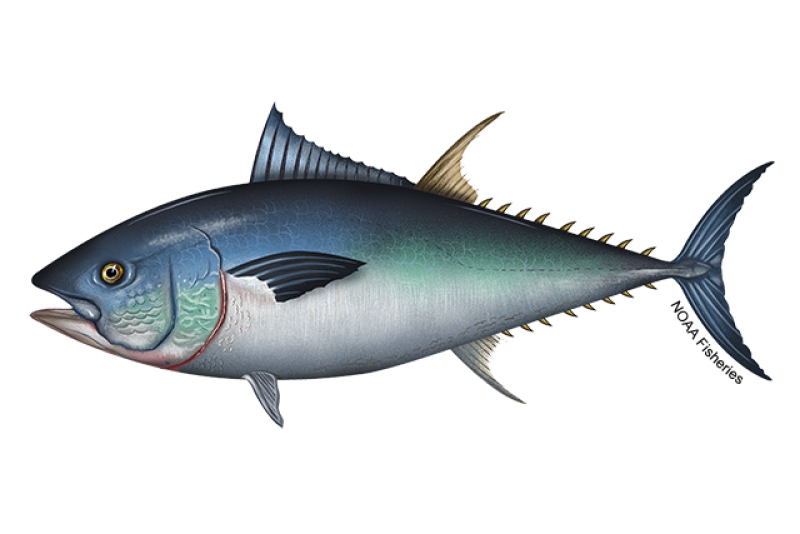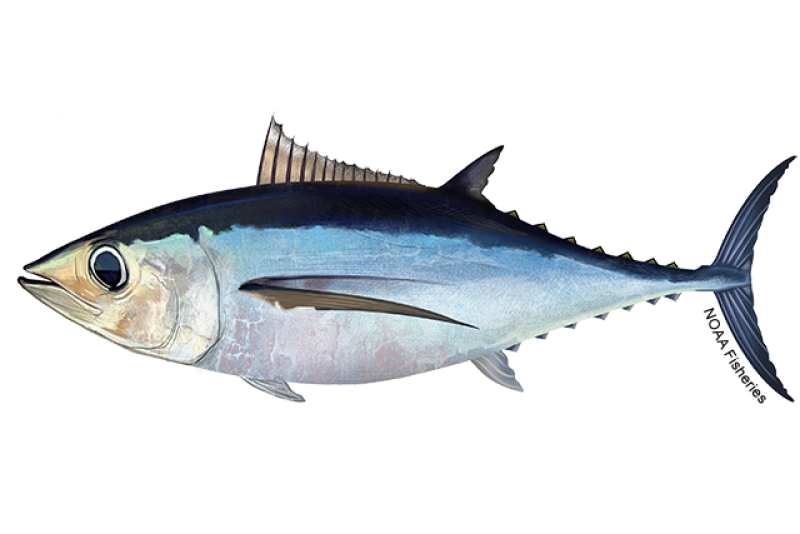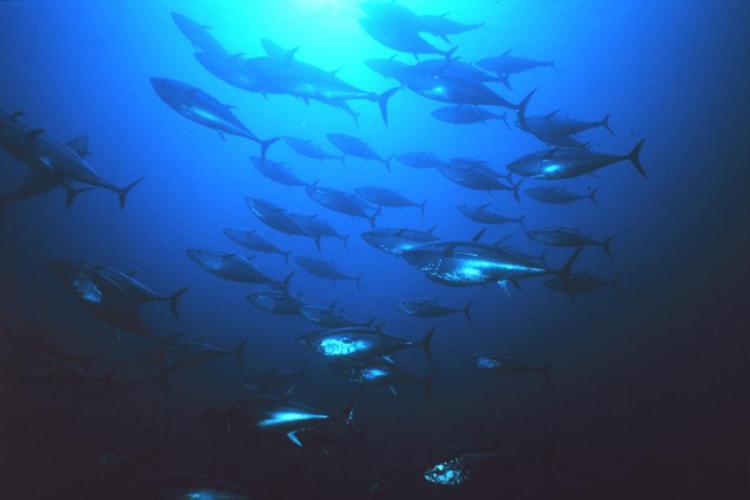 School of bluefin tuna. Credit: NOAA Fisheries
School of bluefin tuna. Credit: NOAA Fisheries
School of bluefin tuna. Credit: NOAA Fisheries
About the Species
 School of bluefin tuna. Credit: NOAA Fisheries
School of bluefin tuna. Credit: NOAA Fisheries
School of bluefin tuna. Credit: NOAA Fisheries
U.S. wild-caught Pacific bluefin tuna is a smart seafood choice because it is sustainably managed and responsibly harvested under U.S. regulations.

Population
The stock is not overfished.

Fishing Rate
Not subject to overfishing.

Habitat Impact
Fishing gear used to catch bluefin tuna rarely contacts the seafloor so habitat impacts are minimal.

Bycatch
Regulations are in place to minimize bycatch.
Population Status
- According to the 2024 stock assessment, Pacific bluefin tuna is not overfished and not subject to overfishing. Summary stock assessment information can be found on Stock SMART.
Appearance
- Pacific bluefin tuna have black or dark blue dorsal sides, with a grayish-green iridescence.
- Their bellies are dotted with silver or gray spots or bands.
- They have a series of small yellow fins, edged in black, running from the second dorsal fin to the tail.
- A distinguishing characteristic of Pacific bluefin tuna is that the tips of the pectoral fins do not reach the front of the second dorsal fin.
- They have relatively small eyes compared to other species of tuna.
Biology
- Pacific bluefin tunas reach maturity at approximately 5 years of age and can live up to 26 years, although the average lifespan is about 15 years.
- Adults are approximately 1.5 meters (4 feet 11 inches) long and weigh about 60 kilograms (130 pounds).
- The maximum reported length and weight for Pacific bluefin tuna is 3 meters (9.8 feet) in length and 450 kilograms (990 pounds).
- Pacific bluefin tunas are predatory and mainly eat squids and fish, such as sardines and anchovies, saury, herring, pompanos, mackerel, hake, other tunas, and occasionally red crabs and krill.
Where They Live
Range
- Most of the U.S. catch of Pacific bluefin tuna is within about 100 nautical miles of the California coast.
Habitat
- Bluefin tuna are highly migratory and travel long distances throughout the Pacific Ocean.
- They are found mostly in temperate ocean waters but also in the tropics and cooler coastal regions.
- Of the tunas, Pacific bluefin tuna have the largest geographic range.
- Tagging studies have revealed that some bluefin spend their entire lives in the Western Pacific Ocean, while others migrate to the Eastern Pacific Ocean. The trans-Pacific journey can take as little as 55 days.
Fishery Management
- Management of highly migratory species, such as Pacific bluefin tuna, is complicated because they migrate thousands of miles across oceans and international borders and are fished by many nations.
- Effective conservation and management of these resources requires international cooperation as well as strong domestic management. The United States continues to encourage harvest levels internationally that rebuild the population.
- Two international organizations, the Inter-American Tropical Tuna Commission (IATTC) and the Western and Central Pacific Fisheries Commission (WCPFC) coordinate management of this fishery across jurisdictions of member and cooperating nations. Working with the U.S. Department of State, NOAA Fisheries implements the IATTC and WCPFC conservation and management measures as regulations for U.S. fleets.
- NOAA Fisheries and the Pacific Fishery Management Council and the Western Pacific Fishery Management Council manage this fishery on the West Coast and in the Pacific Islands under the Fishery Management Plan for U.S. West Coast Fisheries for Highly Migratory Species and the Fishery Ecosystem Plan for the Pelagic Fisheries of the Western Pacific, respectively.
- NOAA Fisheries works with the councils to provide recommendations to the Commissions and implement domestic regulations under the authority of the Magnuson-Stevens Fishery Conservation and Management Act (MSA).
- The councils provide advice to NOAA Fisheries and the Department of State, so that the councils’ interests are represented in international negotiations.
- Councils will also develop recommendations for domestic regulations to address the relative impact on the stock by U.S. vessels.
- NOAA Fisheries determined the Pacific bluefin tuna stock to be overfished in 2013. Domestic and international measures were put in place, and the stock was determined to be rebuilt in 2024.
Harvest
- Commercial fishery:
- The average annual bluefin landings by U.S. commercial vessels fishing in the eastern Pacific Ocean represent only 2 percent of the average annual landings from all fleets fishing there.
- U.S.-caught Pacific bluefin tuna are commonly landed in California by fishermen who sell to local restaurants.
- In 2023, U.S. commercial landings of Pacific bluefin tuna totaled 400,000 pounds and were valued at $2.3 million, according to the NOAA Fisheries commercial fishing landings database.
- Gear types, habitat impacts, and bycatch:
- Purse seine, hook-and-line, and harpoon gear are used to catch Pacific bluefin tuna.
- Fishing gear used to catch bluefin tuna rarely contacts the seafloor so habitat impacts are minimal.
- These fishing methods are fairly selective and allow for the live release of unintentionally caught species.
- Recreational fishery:
- Pacific bluefin tuna are a highly valued species by recreational anglers.
- West Coast recreational fishing grounds primarily include offshore waters of southern California and northern Baja, and have historically included waters as far north as Monterey Bay.
- Commercial passenger fishing vessels and private boaters target Pacific bluefin tuna with recreational fishing gear using live bait (sardines or anchovy), casting jigs, and trolling jigs.
Scientific Classification
- Most of the U.S. catch of Pacific bluefin tuna is within about 100 nautical miles of the California coast.
- Bluefin tuna are highly migratory and travel long distances throughout the Pacific Ocean.
- They are found mostly in temperate ocean waters but also in the tropics and cooler coastal regions.
- Of the tunas, Pacific bluefin tuna have the largest geographic range.
- Tagging studies have revealed that some bluefin spend their entire lives in the Western Pacific Ocean, while others migrate to the Eastern Pacific Ocean. The trans-Pacific journey can take as little as 55 days.
Fishery Management
- Management of highly migratory species, such as Pacific bluefin tuna, is complicated because they migrate thousands of miles across oceans and international borders and are fished by many nations.
- Effective conservation and management of these resources requires international cooperation as well as strong domestic management. The United States continues to encourage harvest levels internationally that rebuild the population.
- Two international organizations, the Inter-American Tropical Tuna Commission (IATTC) and the Western and Central Pacific Fisheries Commission (WCPFC) coordinate management of this fishery across jurisdictions of member and cooperating nations. Working with the U.S. Department of State, NOAA Fisheries implements the IATTC and WCPFC conservation and management measures as regulations for U.S. fleets.
- NOAA Fisheries and the Pacific Fishery Management Council and the Western Pacific Fishery Management Council manage this fishery on the West Coast and in the Pacific Islands under the Fishery Management Plan for U.S. West Coast Fisheries for Highly Migratory Species and the Fishery Ecosystem Plan for the Pelagic Fisheries of the Western Pacific, respectively.
- NOAA Fisheries works with the councils to provide recommendations to the Commissions and implement domestic regulations under the authority of the Magnuson-Stevens Fishery Conservation and Management Act (MSA).
- The councils provide advice to NOAA Fisheries and the Department of State, so that the councils’ interests are represented in international negotiations.
- Councils will also develop recommendations for domestic regulations to address the relative impact on the stock by U.S. vessels.
- NOAA Fisheries determined the Pacific bluefin tuna stock to be overfished in 2013. Domestic and international measures were put in place, and the stock was determined to be rebuilt in 2024.
Harvest
- Commercial fishery:
- The average annual bluefin landings by U.S. commercial vessels fishing in the eastern Pacific Ocean represent only 2 percent of the average annual landings from all fleets fishing there.
- U.S.-caught Pacific bluefin tuna are commonly landed in California by fishermen who sell to local restaurants.
- In 2023, U.S. commercial landings of Pacific bluefin tuna totaled 400,000 pounds and were valued at $2.3 million, according to the NOAA Fisheries commercial fishing landings database.
- Gear types, habitat impacts, and bycatch:
- Purse seine, hook-and-line, and harpoon gear are used to catch Pacific bluefin tuna.
- Fishing gear used to catch bluefin tuna rarely contacts the seafloor so habitat impacts are minimal.
- These fishing methods are fairly selective and allow for the live release of unintentionally caught species.
- Recreational fishery:
- Pacific bluefin tuna are a highly valued species by recreational anglers.
- West Coast recreational fishing grounds primarily include offshore waters of southern California and northern Baja, and have historically included waters as far north as Monterey Bay.
- Commercial passenger fishing vessels and private boaters target Pacific bluefin tuna with recreational fishing gear using live bait (sardines or anchovy), casting jigs, and trolling jigs.
Scientific Classification
| Kingdom | Animalia | Phylum | Chordata | Class | Actinopterygii | Order | Scombriformes | Family | Scombridae | Genus | Thunnus | Species | orientalis |
|---|
Last updated by NOAA Fisheries on 04/03/2025
Featured News
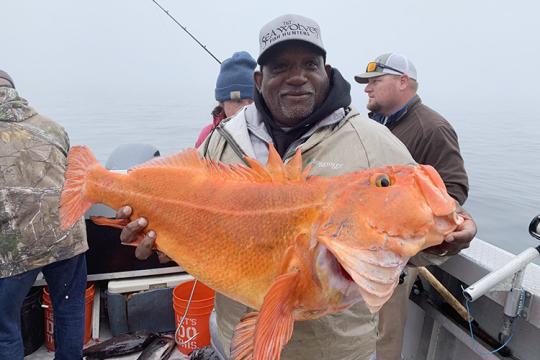
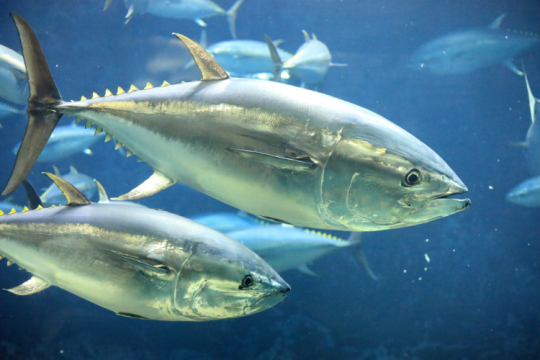 Pacific bluefin tuna swim underwater. Credit: Adobe Stock
Pacific bluefin tuna swim underwater. Credit: Adobe Stock
 Pacific bluefin tuna swim underwater. Credit: Adobe Stock
Pacific bluefin tuna swim underwater. Credit: Adobe Stock
From Overfished to Sustainable Harvests: Pacific Bluefin Tuna Rebound to New Highs
 Juvenile coho salmon. Credit: iStock
Juvenile coho salmon. Credit: iStock
NOAA Fisheries Releases 2023 Status of Stocks
Seafood Facts

Is Pacific Bluefin Tuna Sustainable?
U.S. wild-caught Pacific bluefin tuna is a smart seafood choice because it is sustainably managed and responsibly harvested under U.S. regulations.
Availability
Year-round, but most Pacific bluefin tuna are caught between May and October, and are sold to local restaurants.
Source
U.S. wild-caught along the West Coast, primarily from California.
Taste
Bluefin has a distinctive flavor. With its high fat content, it is especially prized for sushi and sashimi. Cooking is generally not advised as it produces a strong fish taste and odor.
Texture
Bluefin tuna flesh is the darkest and fattiest of any tuna. A higher fat content in bluefin tuna is equated with a higher-quality product. The flesh has the firmness and appearance of beef steaks.
Color
Deep red when uncooked. When cooked, the meat is an off-white or ivory color.
Health Benefits
Bluefin tuna is a very good source of protein, thiamin, selenium, vitamin B6, and omega-3 fatty acids.
Nutrition Facts
Servings: 1; Serving Weight: 100 g (raw); Calories: 144; Protein: 23.33 g; Total Fat: 4.9 g; Total Saturated Fatty Acids: 1.257 g; Carbohydrate: 0 g; Total Sugars: 0 g; Total Dietary Fiber: 0 g; Cholesterol: 38 mg; Selenium: 36.5 mcg; Sodium: 39 mgMore Information
Bluefin Tuna Recipes
Bluefin tuna is prized for its sashimi and makes a delicious seared tuna steak. If you need cooking inspiration, browse these recipes for seared tuna, tuna ceviche, and more!

Last updated by NOAA Fisheries on 04/03/2025
Seafood News
 Celebrate Culinary Arts Month with a sustainable seafood recipe for every month of the year.
Celebrate Culinary Arts Month with a sustainable seafood recipe for every month of the year.
What Your Birth Month Says About Your Next Seafood Recipe
 Fresh-caught taʻape on ice. Credit: Conservation International Hawaiʻi.
Fresh-caught taʻape on ice. Credit: Conservation International Hawaiʻi.
Reducing Waste and Feeding Communities in Hawaiʻi with a Whole Fish Approach
 Chef Tyler Hadfield’s Curried Skate Wings with Tomato-Masala Chutney
Chef Tyler Hadfield’s Curried Skate Wings with Tomato-Masala Chutney
Ring In the New Year With These Crowd-Favorite Seafood Recipes
 NOAA Fisheries, in collaboration with Blue Ocean Mariculture, is conducting a multi-year pilot study to evaluate observational methods and tools for studying Hawaiian monk seal behavior. Courtesy of Blue Ocean Mariculture
NOAA Fisheries, in collaboration with Blue Ocean Mariculture, is conducting a multi-year pilot study to evaluate observational methods and tools for studying Hawaiian monk seal behavior. Courtesy of Blue Ocean Mariculture
AI Meets Aquaculture to Study Hawaiian Monk Seal Interactions With Net Pens
Management Overview
NOAA Fisheries collaborates with several international fishery management bodies to manage the fishery and conserve the species.
Regulatory Actions
Last updated by NOAA Fisheries on 04/03/2025
Documents
Endangered Species Act Status Review Report of Pacific Bluefin Tuna
A 2017 status review report conducted on a petition from the Center for Biological Diversity (CBD)…
Data & Maps
American Samoa Longline Logbook Reports 2023
Logbook summary reports for the 2023 calendar year.
American Samoa Longline Logbook Reports 2022
Logbook summary reports for the 2022 calendar year.
Hawaii and California Longline Logbook Reports 2022
Logbook summary reports for the 2022 calendar year.
Hawaii and California Longline Logbook Reports 2021
Logbook summary reports for the 2021 calendar year.
Research
Fishery Monitoring for West Coast and International Fisheries
We transform fisheries data into fisheries information via summations and statistical analyses to support stock assessments, scientific studies, and national and international data reporting requirements.
Population Dynamics of Coastal Pelagic and Highly Migratory Species in the North Pacific
We conduct analyses supporting the Fishery Management Plans for coastal pelagic species and highly migratory species.
Last updated by NOAA Fisheries on 04/03/2025
